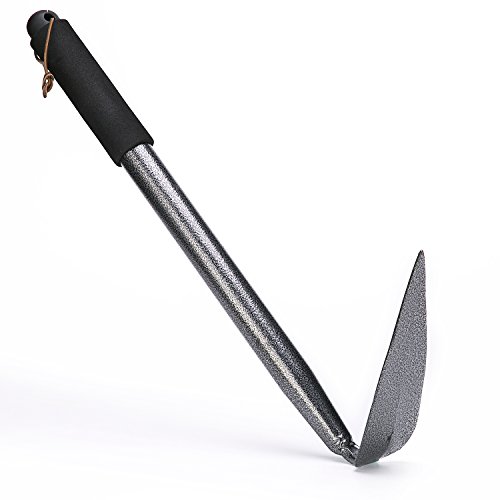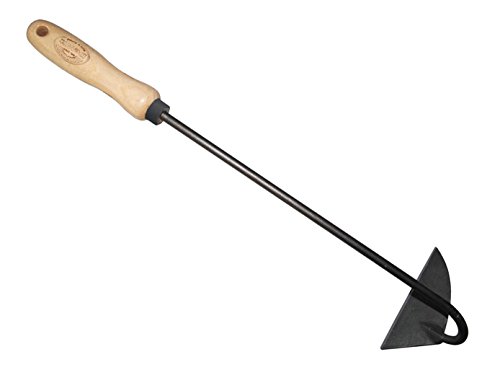As any serious horticulturist knows, a good hoe is one of the most important and versatile tools you’ll use in your garden. It’s used for weeding and cultivating garden beds without having to constantly bend down.
Hoes are also incredibly useful for digging, stirring the soil, making mounds or trenches and even harvesting root crops.

There are many types of garden hoes available, so it’s crucial that you choose the right tool for the job. While most hoes perform a similar function, each design excels at a particular task.
Some garden hoes are better for weeding, others are useful at moving foliage around, and others are designed to work best in smaller spaces.
If you’re unsure of which you need in your garden, see if you can try out a few different ones before purchasing your own. Picking the right one will not only make your job much easier but will also help to keep your back and muscles happy.
Garden Hoe Types
If you look at any garden hoe, you’ll see that they all share the same basic shape. All hoes are made up of a handle, the shaft, with a metal tool, the blade, attached at the end.
While some hoes have wooden handles while others have fiberglass handles, it’s the differences in the type of blade that differentiate what it’s used for.
1. Paddle or Draw Hoe
This type of hoe is the most basic type of hoe and what people usually think of when they think of garden hoes. It’s known by many names, such as a draw, chopping or planter hoe, but its function is the same.
It’s made up of a long shaft with a small rectangular paddle attached to the end at a 90-degree angle.
It’s used by chopping into the ground with it and pulling (drawing) the blade back towards yourself. It can be used to break up weeds by the root, cultivate a garden bed, and shape the soil.
Depending on the angle at which the handle is held, you can use it to cultivate the soil at different depths.
2. Field Hoe
The field hoe is a type of draw hoe that uses a heavy-duty blade that can be used more aggressively than a regular paddle hoe.
Its sharpened blade is often used to everything from weeding and breaking ground to removing small trees.
It’s a tough multipurpose tool that can handle almost any garden task and is a perfect tool if you have a lot of landscaping that needs to be done.
3. Warren Hoe
The Warren hoe is a variation on the draw hoe that uses a triangular blade, a spade, instead of a rectangular one.
This makes it very convenient for use in tight areas as the point of the spade can be better directed towards a particular spot.
The Warren hoe is also great at digging out difficult weeds or cultivating around and under plants without damaging the roots. They are also often used to dig furrows or shallow trenches when preparing a garden bed for planting seeds and bulbs.
4. Dutch Hoe
Dutch hoes are a type of hoe called a scuffle hoe. Unlike draw hoes, scuffle hoes are meant to be pushed or pulled (scuffled) around the soil to break up and cut the roots along the soil’s surface.
Dutch hoes have a small rectangular blade that’s sharp on every side, allowing it to cut forwards, backward or side-to-side.
Instead of being angled downward perpendicular to the shaft, the blade on a dutch hoe is slightly inclined upward. This design allows users to push the blade right below the surface of the soil and move it around to weed an area.
5. Collinear Hoe
Another type of scuffle hoe, the collinear hoe has a long, thin, and a very sharp blade that is used to easily slice through weed roots just under the surface of the soil.
It’s very useful for easily weeding under foliage with a smooth sweeping motion.
Because it’s used for light weeding, such as around onions and garlic plants, it’s also known as an onion hoe. The extra width can make it difficult to use around crowded beds, however.
6. Loop Hoe
Also known as a shuffle, stirrup or hula hoe, the blade on a loop hoe looks like a saddle’s stirrup and can come very handy when fighting against hard-to-reach weeds.
This type of scuffle hoe can be used with a back and forth motion to dig up stubborn weeds deep in the soil as well as tear up smaller weeds right on the surface.
Loop hoes are used with the handle held upright, giving you better visibility and accuracy when working on your garden bed.
7. Action Hoe
An action hoe, also known as a reciprocating hoe, is the only kind of hoe on this list with moving parts. The blade on an action hoe has a pivot that scrapes the soil at an angle of 15 to 20 degrees as you push and pull the hoe alongside the soil.
Action hoes are very useful for aggressive weeding as well as preparing the soil between rows.
They can also be used very close to crop plants as the vertical sides offer good control and visibility, allowing you to weed the area without potentially damaging your crops.
8. Push-Pull Hoe
The unique V-shaped design of the push-pull hoe combines the sharp triangular blade of a warren hoe with the saddle design of the loop hoe, creating a truly multipurpose tool that blends the benefits of both draw and scuffle hoes.
Push the sharp point into the soil to break up the soil and cut even the deepest weeds, root and all. Then pull in back to move the entire weed out of your garden bed.
The push-pull hoe allows you to gently work along the surface or dig deep to devastate all the weeds hiding down below.
Push-pull hoes are also well suited for gardens with drip irrigation systems. The accuracy of the push-pull hoe lets you remove weeds without potentially cutting into the drip irrigation lines.
If your tubing is on top of the soil, the push-pull hoe can easily slide right underneath to get at all the weeds around the trunk line.
9. Swan Neck Hoe
The swan neck hoe is another variation on the scuffle hoe. This design, however, features a long, curved neck that connects to a sharp blade that lies flat against the ground. Just it slides under the surface of the soil to easily cut through roots and weeds.
Unlike other scuffle hoes, swan neck hoes are designed to be used while standing. Their ergonomic design reduces the need to bend down or stoop over your garden bed, making yard work easier on your back.
In Summary
As you work on your garden, keep these hoes in mind. Noticing the kind of weeding that you do most of and the positions of your body that are most comfortable will help you decide which hoe is most suited for your garden.
You may even realize that owning a few different garden hoes maybe what’s most convenient, as each provides some benefits that the others do not.
Ensuring that you choose the right one will make your time gardening easier, less physically tiring, and a whole lot more fun!
















